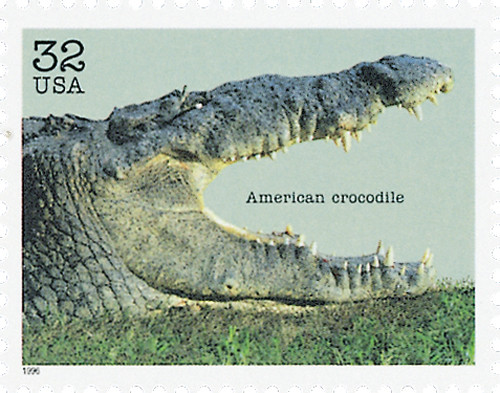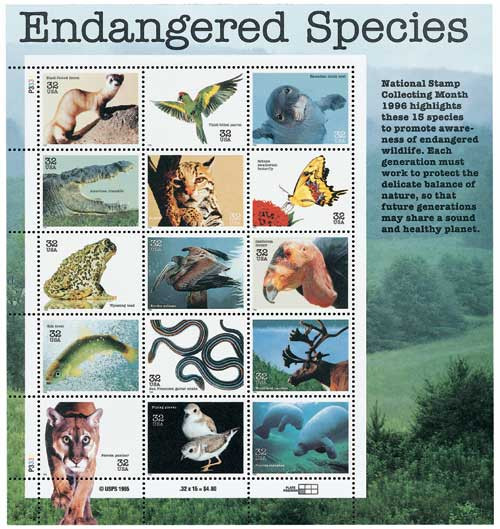
# 3105d - 1996 32c Endangered Species: American Crocodile
US #3105d
1996 American Crocodile
- Part of set of 15 stamps picturing Endangered Species
- Issued during National Stamp Collecting Month
Stamp Category: Commemorative
Set: Endangered Species
Value: 32¢First-Class mail rate
First Day of Issue: October 2, 1996
First Day City: San Diego, California
Quantity Issued: 14,910,000
Printed by: Ashton-Potter (USA) Ltd.
Printing Method: Lithographed
Format: Panes of 15 (3 across, 5 down) from printing plates of 90 (9 across, 10 down)
Perforations: 11.1 x 11
Why the stamp was issued: The pane of 15 Endangered Species stamps was issued as part of the US Postal Service’s National Stamp Collecting Month. The theme for 1996 was “Collect and Protect.” The USPS hoped these stamps would appeal to children, who would then become lifelong stamp collectors.
About the stamp design: The stamps show photographs of 15 animal species that live in America and re threatened with extinction. The photos were taken by James Balog. The animals chosen for the stamps are from all major geographic areas of the US.
First Day City: The First Day of Issue ceremony took place at the San Diego Zoo. In 1996, the zoo was celebrating its 80th birthday. The country of Mexico issued its own pane of endangered species stamps on the same day and took part in the First Day of Issue ceremony. (The stamps were not a joint issue.) In addition to honored human guests, two sea lions, an Andean condor, and a North American timber wolf were also in attendance at the celebration.
Unusual fact about the Endangered Species stamps: The 1996 National Stamp Collecting Month was co-sponsored by the US Postal Service and the American Zoo and Aquarium Association.
About the Endangered Species Set: The species shown on the pane of Endangered Species stamps are: Black-footed Ferret, Schaus Swallowtail Butterfly, Brown Pelican, San Francisco Garter Snake, Ocelot, Gila Trout, Hawaiian Monk Seal, Thick-billed Parrot, California Condor, Wyoming Toad, Woodland Caribou, Florida manatee, Florida Panther, Piping Plover, and American Crocodile. All of them are listed on the US Fish and Wildlife Service’s List of Endangered and Threatened Wildlife and Plants.
History this stamp represents: The future of the American crocodile is not promising. Loss of habitat, expanding civilization, and hide hunters have all taken their toll, reducing this species’ population to a few hundred.
Often confused with the American alligator, the American crocodile is slightly smaller (although it can grow up to 12 feet in length) with a more tapered, triangular-shaped snout. In addition, the fourth tooth in the lower jaw is more distinct and always visible, even when the mouth is closed. Primarily nocturnal, crocodiles spend much of the day sunning themselves. They prefer brackish, slow-moving, warm water and are often found near swamps and mangrove-lined inlets. At night they move out into creeks and coastal waterways where they prey on fish, crabs, birds, and turtles.
In an effort to stabilize the population, biologists have begun collecting eggs and hatching them in incubators. Once they are able to defend themselves against smaller predators, the young crocodiles are released into the wild. However, they must still survive fierce territorial battles with older crocodiles, and many are hit by cars while taking advantage of the retained heat of nearby roadways. Constant monitoring and increased recovery efforts are the crocodile’s only hope for survival.
US #3105d
1996 American Crocodile
- Part of set of 15 stamps picturing Endangered Species
- Issued during National Stamp Collecting Month
Stamp Category: Commemorative
Set: Endangered Species
Value: 32¢First-Class mail rate
First Day of Issue: October 2, 1996
First Day City: San Diego, California
Quantity Issued: 14,910,000
Printed by: Ashton-Potter (USA) Ltd.
Printing Method: Lithographed
Format: Panes of 15 (3 across, 5 down) from printing plates of 90 (9 across, 10 down)
Perforations: 11.1 x 11
Why the stamp was issued: The pane of 15 Endangered Species stamps was issued as part of the US Postal Service’s National Stamp Collecting Month. The theme for 1996 was “Collect and Protect.” The USPS hoped these stamps would appeal to children, who would then become lifelong stamp collectors.
About the stamp design: The stamps show photographs of 15 animal species that live in America and re threatened with extinction. The photos were taken by James Balog. The animals chosen for the stamps are from all major geographic areas of the US.
First Day City: The First Day of Issue ceremony took place at the San Diego Zoo. In 1996, the zoo was celebrating its 80th birthday. The country of Mexico issued its own pane of endangered species stamps on the same day and took part in the First Day of Issue ceremony. (The stamps were not a joint issue.) In addition to honored human guests, two sea lions, an Andean condor, and a North American timber wolf were also in attendance at the celebration.
Unusual fact about the Endangered Species stamps: The 1996 National Stamp Collecting Month was co-sponsored by the US Postal Service and the American Zoo and Aquarium Association.
About the Endangered Species Set: The species shown on the pane of Endangered Species stamps are: Black-footed Ferret, Schaus Swallowtail Butterfly, Brown Pelican, San Francisco Garter Snake, Ocelot, Gila Trout, Hawaiian Monk Seal, Thick-billed Parrot, California Condor, Wyoming Toad, Woodland Caribou, Florida manatee, Florida Panther, Piping Plover, and American Crocodile. All of them are listed on the US Fish and Wildlife Service’s List of Endangered and Threatened Wildlife and Plants.
History this stamp represents: The future of the American crocodile is not promising. Loss of habitat, expanding civilization, and hide hunters have all taken their toll, reducing this species’ population to a few hundred.
Often confused with the American alligator, the American crocodile is slightly smaller (although it can grow up to 12 feet in length) with a more tapered, triangular-shaped snout. In addition, the fourth tooth in the lower jaw is more distinct and always visible, even when the mouth is closed. Primarily nocturnal, crocodiles spend much of the day sunning themselves. They prefer brackish, slow-moving, warm water and are often found near swamps and mangrove-lined inlets. At night they move out into creeks and coastal waterways where they prey on fish, crabs, birds, and turtles.
In an effort to stabilize the population, biologists have begun collecting eggs and hatching them in incubators. Once they are able to defend themselves against smaller predators, the young crocodiles are released into the wild. However, they must still survive fierce territorial battles with older crocodiles, and many are hit by cars while taking advantage of the retained heat of nearby roadways. Constant monitoring and increased recovery efforts are the crocodile’s only hope for survival.











